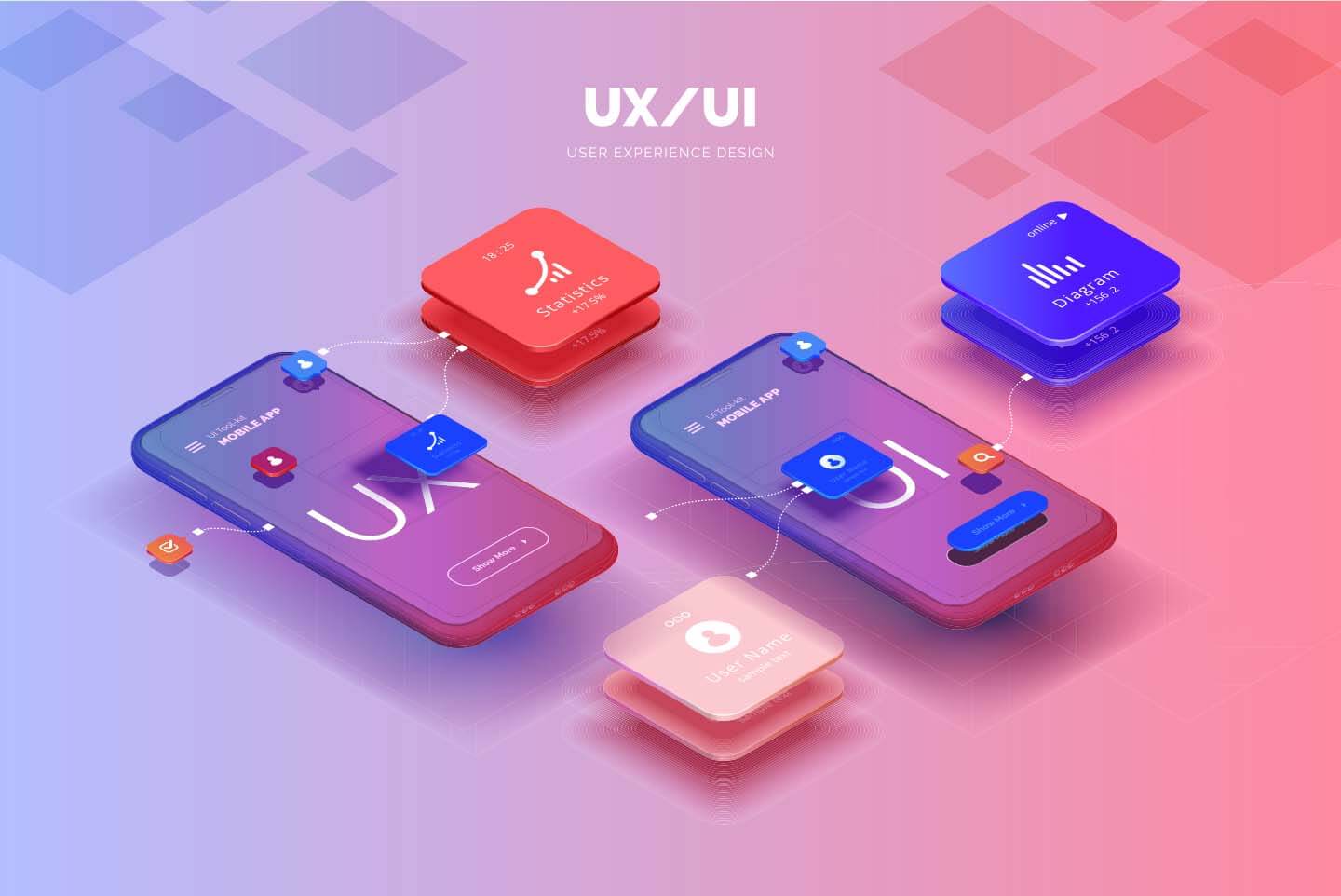
What Is User Interface (UI) Design?
User interfaces are the access points where users interact with designs. User interface design is the process designers use to build these interfaces in software or computerized devices. Good UI design has an emphasis on presentation, look, feel, and overall style without sacrificing usability. Designers seek to provide interfaces, which users find easy to use and pleasurable to keep them coming back and happy with their experience.
There is no one type of user interface. But it can be thought of as the design created to allow a user to interact with the product. Taking a mobile phone app as an example, the interface would be the screen that the user sees when he or she enters into an application. Or, in the case of a voice-activated device, there is an audio UI.
What Does an Interface Do?
As stated previously, an interface is the access point a user engages with to interact with a product. It is the series of digital commands created by a developer or engineer and input into a physical device that the user leverages to use the product. The interface could be the screen on an app that takes a user through a series of steps and visuals to make a purchase or play a game. Or an interface could be a voice activating a device such as Siri. Think of the interface as the tool a user leverages to achieve the desired outcome. It is the gateway to the product.

Types of Interfaces
There are three general types of interfaces that designers can be required to build.
- Graphical user interfaces (GUIs)— Users interact with visuals through digital devices such as a computer desktop or an application on the phone.
- interfaces (VUIs)—These are interfaces that users will use to interact through voice. These interfaces have different requirements than GUIs. Siri and Alexa are both examples of VUIs.
- Gesture-based interfaces— In gesture-based interfaces, users are engaging with augmented or virtual reality in 3D design. The interactions often happen through the user moving through space based on visual cues displayed within a screen or goggles.
What Does a UI Developer Do?
As discussed, user interface design is 100% digital, and unlike UX, UI does not exist in the non-digital sphere. This requires technical skill sets that can be leveraged to create visuals. The UI developer is in charge of the navigation of the interface. The designer or developer must take into consideration the visual and interactive elements of a product’s interface, these include the buttons, visuals, spacing, typography, color, shading— and last but not least the responsiveness of the design. It is the designer’s responsibility to take all these things into account and build them into the interface in a way that is intuitive and doesn’t require much effort to use the product. The UI design should guide the user through the product’s interface without giving the user pause to question the flow of the interface or the usability of the product.
Furthermore, the UI design should be in line with the brand’s image and incorporate already existing assets such as a logo or color scheme. The design of the interface will communicate a brand's messaging through details in an aesthetically pleasing manner. The designer will need to consider and weigh all of the above elements to create the best user interface possible that also represents the quality of the brand.
What Skills Do UI Designers Need?
To find work as a reliable and respected UI designer, the following skill sets are a good starting point, but by no means an exhaustive representation of requirements.
- Fluency in front-end web development languages, i.e., HTML, CSS and JavaScript.
- Skills in modern application programming languages, such as Java, .Net, AJAX, PHP, XHTML and Ruby.
- Knowledgeable in Adobe Creative Suite programs, such as Photoshop, Illustrator, Flash & Flex.
- Be able to use responsive web design to create applications that automatically conform to multiple screen sizes/devices.
- Be able to test for UI issues and help to gather information from target users.
- Integrate network APIs (from Facebook, Twitter, Google+, LinkedIn, Pinterest, etc.) to integrate social actions.
What Is the Difference Between a UI and UX Developer?
UI vs UX (user experience) is an area of confusion for many people. UI and UX work in conjunction together but each has its own duties and responsibilities to help best serve a user.
UX design is all about the overall feel of the experience and includes problem-solving of a user’s journey. UX examines what steps will be taken, and what the problem is that the user needs solved. UX is occupied with creating the best experience possible to enable the user to solve his/her problem as quickly and efficiently as possible.
Once the UX has mapped out everything, the UI comes into play to bring to life the visual aspects of the user journey. The UI is concerned with the visuals and the aesthetics of the user’s interaction. The swiping, tapping, and scrolling on a page are all a part of the UI design process.
Both UX and UI, however, share the same end goal of creating a product that delights the user and keeps him or her engaged with the product.
To sum it up, Rahul Varshney, co-creator of Foster.fm has a great analogy:
“User Experience (UX) and User Interface (UI) are some of the most confused and misused terms in our field. A UI without UX is like a painter slapping paint onto a canvas without thought; while UX without UI is like the frame of a sculpture with no paper mache on it. A great product experience starts with UX followed by UI. Both are essential for the product’s success.”

This chart may also help distinguish between UI and UX:
| UX | UI |
| Product structure and strategy | Design research and strategy |
| Content development | Design asset creation (branding) |
| General problem solving | Visual problem solving |
| Work with developers | Interactivity and animation |
| Testing and iterations | Adapting to multiple screen sizes |
| Getting user from point A to B with ease | Getting user from point A to B with ease |
What are the Benefits of UI Design?
Why would a business want to invest in the UI design of its product? To put it simply, UI design is a necessary investment for a business because it is the tactile, visual and possibly audio way that users will interact with the product in the digital space. It is important that the interaction goes seamlessly and is handled by a team of experts. With a saturated market in phone apps, for example, users are incredibly fickle and demand perfection. Anything less than perfect, and they will switch to a competitor app. If the UI is not easy to use or visually pleasant, this is more than reason enough for a user to jump ship. Investing in UI design means fewer problems and increases functionality, thereby increasing happy customers.
How to Build Great UI Designs
The golden rule with UI design is to remember that your users are human beings! They have finite amounts of patience and time. They also have needs or problems and they’re looking to your product for help. An interface should never abuse this trust. You want to get them through your interface as easily and quickly as possible.
While there’s no one way to create great UI design, the following guidelines and tips are generally agreed upon.
- Keep interfaces simple with one item or task per page.
- Make buttons or calls to action simple and predictable. Place them in easy to spot locations and properly sized.
- Draw attention to main features by using color (as appropriate) and font size.
- Emphasize hierarchy and readability, placing the most important buttons etc easily visible. Select type fonts and sizes that are easily legible taking into consideration that the client may be using a small screen such as a mobile phone to use the interface.
- Keep typing to a minimum. Avoid asking the user to type whenever possible, as this is time consuming and, when using a smaller device, challenging.
- Users should be kept informed as to responses from the system and actions with appropriate feedback. For example, a pop up window or a scrolling dial will let a user know that a form is being processed.
- Next steps should be apparent for users as they progress through the interface.
- Maintain consistency with the brand throughout the UI design.
- When possible, take advantage of data to help you make more informed decisions regarding your user interface.
Keep in mind that throughout the UI process, the design should always seek to give users the most direct and best experience. Keep it easy and simple. As the Interaction Design Foundation blog puts it, the big question that designers should always be asking themselves is: can I make things simpler for our end user?
How to Select the Right UI Partner for Your Business
Selecting the right partner to complete your UI design is an important decision. The UI design team will be responsible for the “face” that your users encounter when engaging with your product. Your design is your first impression and it’s common knowledge that there’s no second chance to make a first impression. The people handling this first impression and design functionality should be well equipped with the skills necessary to do the job, and beyond this, consider the following assets.
Connection
You want to make sure that the team you hire for your visual design really understands your brand’s visual identity. Whether the UI team will also do all the branding for your business or not, you must have good communication around how the interface will appear and its visuals.
Expertise
The following are considerations that should be taken into account when searching for the best UI design team to partner with. You’ll want to work with a team that has experience in UI interface design and development. Good things to look for are expertise in the following areas:
- Product Branding
- Past Interface Design
- Context Analysis
- Product Pathway
Past Work
You’ll want to see a body of previous work with clients. The work should be well-executed and also have a look and feel that could fit into your business’ UI. Ask to see samples of work and whenever possible, to speak with past clients about their working experience.
About Pixel506
If you're looking for a nearshore user interface partner, user experience, development service or a technical staff augmentation service , Pixel506 can help. We are located in Costa Rica but also have Pixelians (team members) based in Peru, Nicaragua, and Colombia and New York. We help businesses gain a competitive advantage and exceed business goals through software development, design, user experience strategies, data, and innovative solutions. Founded in 2009, we have over a decade of experience helping big, medium, and small companies succeed in the digital world. Contact us today to see how we can help―we look forward to getting to know you and your business over a digital cup of coffee.
Key Takeaways:
- User interfaces are the access points where users interact with designs. Think of the interface as a tool used to achieve a desired outcome.
- A user interface is the series of digital commands created by a developer or engineer and input into a physical device that the user leverages to use the product.
- There are three types of interfaces: graphical user interfaces, voice controlled interfaces and gesture-based interfaces.
- The UI developer is in charge of the navigation of the interface. The designer or developer must take into consideration the visual and interactive elements of a product’s interface.
- UX design is all about the overall’s feel of the experience and includes problem solving of a user’s journey, whereas UI is about the design of the user’s experience.
- UI design is a necessary investment for a business because it is the tactile, visual and possibly audio way that users will interact with the product in the digital space. It is important that the interaction goes seamlessly and is handled by a team of experts.
- To build outstanding UI design, the golden rule is to remember that your users are human beings! They have finite amounts of patience and time. They also have needs or problems and they’re looking to your product for help.
- Make it easy for your users to find the solutions they’re seeking— this is part of good UI design.
Reference
- https://careerfoundry.com/en/blog/ux-design/the-difference-between-ux-and-ui-design-a-laymans-guide/#what-is-user-interface-ui-design
- https://www.interaction-design.org/literature/topics/ui-design
